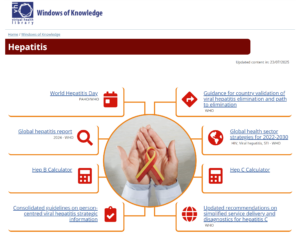World Hepatitis Day has been celebrated on July 28 since 2010, a date chosen in honor of the birthday of Dr. Baruch Blumberg, winner of a Nobel Prize for discovering the hepatitis B virus and developing its diagnostic test and vaccine. Each year, this date reinforces the need to intensify national and international efforts to eliminate viral hepatitis.
For 2025, the global campaign adopts the theme “Hepatitis: Let’s break it down!” which calls on governments, civil society, and partners to dismantle financial, social, and systemic barriers, including stigma, that hinder access to hepatitis prevention, diagnosis, and treatment, as well as liver cancer prevention. The focus of the efforts coordinated by the WHO and the Pan American Health Organization (PAHO) is on simplifying, expanding, and integrating vaccination services, safe practices, harm reduction, testing, and treatment into national health systems.
Estimates from the World Health Organization (WHO) indicate that in 2022, approximately 254 million people were living with hepatitis B and 50 million with hepatitis C, causing approximately 1.3 million deaths annually, many of them from cirrhosis and liver cancer. Although hepatitis B is preventable by vaccination and hepatitis C is curable with direct-acting antivirals, testing coverage is less than 20% globally, and less than 10% of those infected with hepatitis C received treatment in 2020. According to multilateral health agencies, it is possible to prevent 2.8 million deaths by 2030, but only if countries act now. The elimination of hepatitis is within our reach.
Key challenges
The biggest obstacles to achieving the 2030 elimination targets include low testing coverage—an essential intervention for early diagnosis—limited access to direct-acting antivirals for hepatitis C, insufficient implementation of harm reduction measures in key populations, and persistent social stigma that drives vulnerable people away from health services. In addition, financial and systemic gaps exacerbate underreporting and non-adherence to treatment.
Priority actions
To move toward elimination, the following is recommended:
- Expand hepatitis B vaccination, ensuring a dose at birth within 24 hours, followed by three booster doses.
- Expand testing and screening, integrating hepatitis B and C testing into primary care facilities and HIV/TB (tuberculosis) services.
- Ensure access to effective treatments, such as direct-acting antivirals for hepatitis C and antivirals for hepatitis B in appropriate regimens.
- Implement harm reduction programs, especially for injecting drug users.
- Address stigma through educational campaigns that promote information and acceptance.
Role of BIREME/PAHO/WHO
BIREME, as PAHO/WHO’s center specializing in information for action in health, supports the global response to hepatitis through platforms such as DeCS – Health Sciences Descriptors, which facilitates access to indexed scientific literature on viral hepatitis, and the Hepatitis Window of Knowledge, which brings together updated documents, guidelines, and communication materials. These tools strengthen public policy formulation and the training of health professionals in the Region of the Americas.
